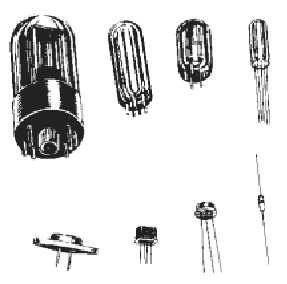1-4
electronic equipments that use semiconductor devices. All of the specific applications of semiconductor
devices would make a long impressive list. The fact is, semiconductors are being used extensively in
commercial products, industry, and the military.
SEMICONDUCTOR COMPETITION
It should not be difficult to conclude, from what you already know, that semiconductor devices can
and do perform all the conventional functions of rectification, amplification, oscillation, timing,
switching, and sensing. Simply stated, these devices perform the same basic functions as the electron
tube; but they perform more efficiently, economically, and for a longer period of time. Therefore, it
should be no surprise to you to see these devices used in place of electron tubes. Keeping this in mind, we
see that it is only natural and logical to compare semiconductor devices with electron tubes.
Physically, semiconductor devices are much smaller than tubes. You can see in figure 1-1 that the
difference is quite evident. This illustration shows some commonly used tube sizes alongside
semiconductor devices of similar capabilities. The reduction in size can be as great as 100:1 by weight
and 1000:1 by volume. It is easy to see that size reduction favors the semiconductor device. Therefore,
whenever miniaturization is required or is convenient, transistors are favored over tubes. Bear in mind,
however, that the extent of practical size reduction is a big factor; many things must be considered.
Miniature electron tubes, for example, may be preferred in certain applications to transistors, thus keeping
size reduction to a competitive area.
Figure 1-1.—Size comparisons of electron tubes and semiconductors.
Power is also a two-sided story. For low-power applications, where efficiency is a significant factor,
semiconductors have a decided advantage. This is true mainly because semiconductor devices perform
very well with an extremely small amount of power; in addition, they require no filaments or heaters as in
the case of the electron tube. For example, a computer operating with over 4000 solid-state devices may
require no more than 20 watts of power. However, the same number of tubes would require several
kilowatts of power.
For high-power applications, it is a different story — tubes have the upper hand. The high-power
tube has no equivalent in any semiconductor device. This is because a tube can be designed to operate

